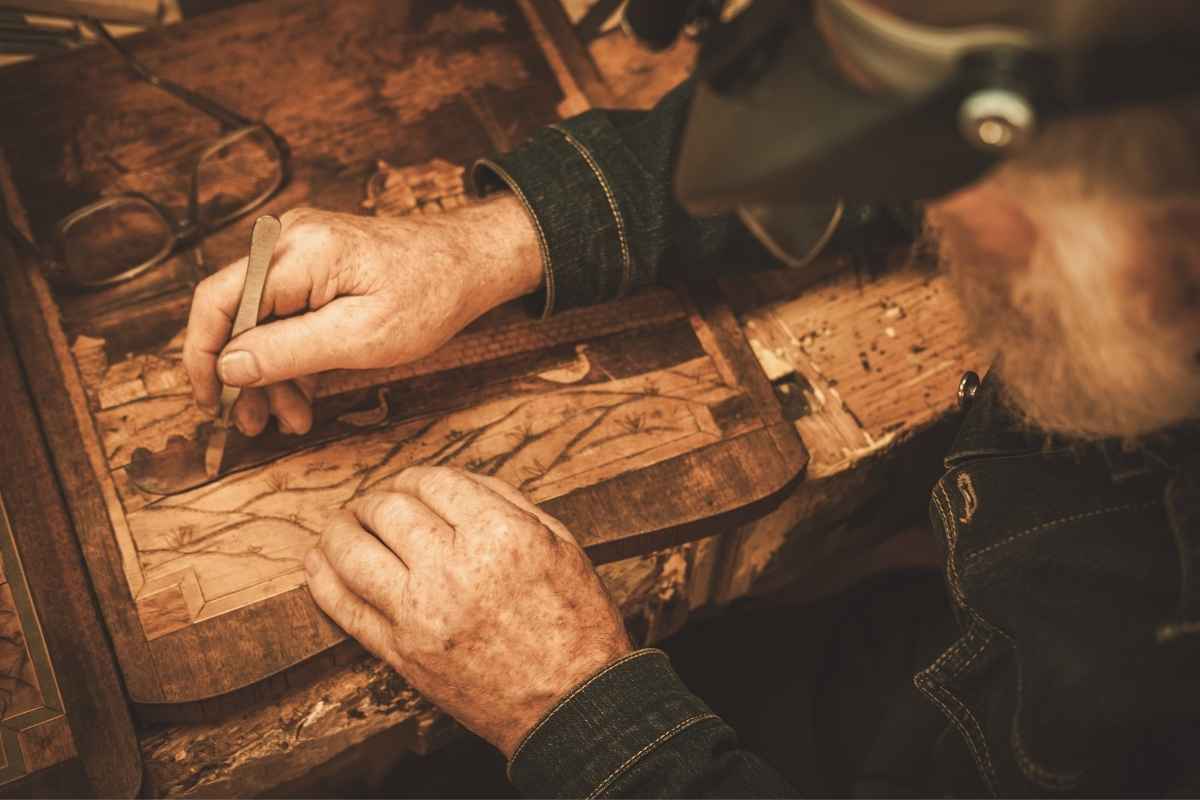
To work in the area of painting is extraordinary in many ways. Some would say it is as boring as watching paint dry. Others like myself and perhaps you would agree that painting as a profession is the best job in the world.
As an artist, you are able to explode with creativity and bring brilliant colors and shapes and ideas together in a work of art. If you go professional, you are able to get paid for being a painter with jobs ranging from fine artist to muralist.
1. “Fine Artist” is Often the First Job Title for Professional Painters

The most open-ended painting job is that of a fine artist. As a fine artist, you are able to paint openly on any subject that you want. These paintings and works of art become your products.
You can then show it to an audience at an exhibit or sell it to patrons and customers. You might also be provided with commissions for art by patrons who desire you to paint a certain exposition or event. This may include portraits where patrons sit for you, as explained next.
2. Next, Everyone Tries Their Hand at Being a Portrait Artist
A portrait artist provides an income for everyone, from caricature artists at carnivals and zoos to portrait painters for royalty. Here is where practicing facial features with paint and pencil will serve a painter well. It’s all about the facial expressions and highlighting those that stand out as a personality trait.
Not everyone can handle the symmetry, or lack thereof, when painting faces, and this is also a more intimate style of painting. You are most often sitting in front of the subject you are painting as a portrait artist, which requires you to have customer service skills. Yet this experience can also be the most rewarding as a painter.
You have direct connections with your subjects and how they react towards your artwork.
3. Graffiti Artist is Where Anarchist Artists Delve

If you are someone who works with painting yet cannot handle society and the structured confines it brings, go grab a can of spray paint and start creating graffiti. Graffiti is the art defined as “writing or drawings scribbled, scratched, or sprayed illicitly on a wall or other surface in a public place,” according to Google and Oxford Languages. While not the paid and professional work you typically find as a painter, graffiti and tagging streets and walls without permission serves its own purpose.
Whether you are experiencing distress with society or want to show off some of your artwork, the only real rule with graffiti is you need to use spray paint. This allows you to create the vivid visual imagery commonplace for this type of painting in a quick time frame so you don’t get caught by the police. You can also use graffiti as a legal work of art, if you have permission from the property owner.
4. Art Teachers Take the Cake Walk in Terms of Salary and Tenure

For some painters, it takes having a salary to get up and go to work in the morning. It does not have anything to do with painting as a profession–some people are just plain lazy. If you are hired by a school system to come into work and teach children on a regular schedule, this helps to make you productive.
However, you might be bogged down with paperwork and grading so that you are less able to make actual art by painting. But if you get tenure…you will have plenty of time during retirement to paint to your heart’s content…and a retirement fund to pay for your way of avoiding becoming a starving artist!
5. College Art Professors Want to Work at Yale…and They All Know It

The reality is, if you want to teach, you want to go to an Ivy League school. These schools offer the most prestige and provide the greatest opportunity for career advancement. If you can say you worked at Yale University, for example, you could secure most painting gigs in the future.
This is a great addition to a painter’s resume. Any Ivy League school will do, as will schools overseas where you can showcase your international artistic abilities.
6. Art Instructors Are Ready to Teach Art at Any Time, Even Online!

Nowadays, you do not need to apply for a painting job with a school to teach others how to paint. All you need is the internet, a webcam, and a computer. This allows you to teach painting to students professionally and paid capacity through any online teaching platform.
Set up your classes and schedule to instruct others on the history of painting, how to paint for beginners or advanced painting techniques. This is a great way to enhance your own experience as a painter and to gain exposure to your artwork through networking with other painters.
7. Illustrators for Books and Magazines Work Alone and Get Paid Bank
As an illustrator for books and magazines, you have the opportunity to return to the quiet solitude that painting affords artists. I prefer this area of painting myself as you can work more freely with the constructs and subjects you paint. Instead of waiting for commissions, the work of an illustrator typically involves pitching artwork to publishers.
These publishing companies have agents and editors who work with artists and illustrators to illustrate copy, which is written text often as a story that is going to be published in print or online publications. Typically, a publishing company or editor will like the artwork of a particular painter. Then, they will hire that painter to paint a specific type of artwork to be used as a cover image or graphic for the publication.
8. Art Therapists Help Individuals Struggling With Mental or Physical Illnesses Through Art

Artists use art to help themselves cope with internal stresses and external pressures. They use art as an expressive medium to better understand these problems and issues. This also extends to art therapy, where artists are hired to use art as a therapeutic practice.
As an art therapist, you are tasked with creating artistic projects and artworks that will inspire and encourage patients in therapy. The art process is part of art therapy for patients who want to learn ways to express their inner feelings and unexplored ideas.
9. Arts Administrators and Museum Curators Choose Art for Public Displays

As an art administrator or museum curator, your job is to choose works of art that are selected for public viewing. These public displays are set up according to themes, concepts, or time frames in history. In order to curate art, an art administrator must have contact and network with holders of fine art that is readily available to share for public displays.
In addition, a museum curator will have experience in identifying fraudulent works of art and of preservation techniques. While not typically the artist responsible for preserving or restoring artwork, a museum curator or art administrator will have the knowledge of leading a team of artists in this capacity. If you are interested in this area of painting, start taking art history courses from an online school.
In terms of the pay scale, the role of an arts administrator or a museum curator pays well. You can expect to make between $47,000 and $173,000 with a median annual salary of $91,739, according to Comparably. If you want to avoid the starving artist plague, work your way into a job as a museum curator or arts administrator for a company.
This is also one of the more prestigious positions as a painter, mainly due to the salary, but also because you are involved in behind-the-scenes work. You get to see and experience fine art that the public may never see. As an artist, part of your job involves seeing and experiencing works of art that other artists have created.
Therefore, working as a curator of art can help you to become more creative as you explore new tools and techniques for processing concepts through artwork.
10. Art Restoration Specialists Save Old and Decrepit Paintings From Over Exposure

As an art restoration specialist, you work for art museums and curators to restore works of art. This ranges from recently unearthed and overexposed decrepit paintings to highly prized and greatly valued paintings like the Mona Lisa. The work of an art restorer is that of finely removing any dirt or grime from a painting.
The art restorer then uses original painting techniques to replace any paint and imagery lost from the original work. This requires an extensive background in art history and painting techniques to ensure prized works of art are not damaged in the process of restoration. However, such skills are an asset that will ensure you have a valuable career ahead for you as a painter.
11. Residential Home Painters Keep Houses Looking Shiny and Neat-O

Those painters who work in residential home painting are responsible for those dreamy curbside views on freshly painted properties. If you love painting in broad strokes, house painting is the way you want to roll as a professional painter. You get to use tools like paint sprayers to help you manage these huge painted surfaces.
This area of painting includes houses of all styles, which can help you learn more about architecture as a painter. This is an area where you have to paint fast, too, in order to complete jobs as required by project managers or homeowners. Residential home painters can work alone, but most work for a crew, so you must be able to get along well with a team of painters.
Additionally, precision and creativity are often left in the dust with residential home painting. Instead, the goal is to cover entire walls without using too much paint or time, so to maximize profits and efficiency. You also have to deal with customers, especially home owners, who are not satisfied with the paint color they selected for themselves.
Yet being able to drive by a house and say you painted it can be a rewarding side effect of the job.
12. Commercial Painters Go Big and Bold With Painting Projects for Businesses

According to Chron, “Commercial painting and industrial painting provides decoration and attractive aspects to the final product. But its real value is to protect the surface of the object from erosion and disintegration due to use and extreme weather.” If you are someone who has worked in residential home painting, commercial painting is the next step up for professional painters.
Here you are working on large-scale projects, including business and office buildings, as well as skyscrapers. You might also be painting or staining woodwork that includes pool decking or porches, rather than just painting vertically standing walls. This can be a benefit if you have spent years painting walls and want to move to painting flat surfaces to reduce wear and tear on your body.
13. Industrial Painters are Interested in Getting Bids on Massive Painting Jobs

An industrial painter moves right up from a commercial painter. What is the difference between an industrial painter and a commercial painter? Industrial painters are responsible for painting protective coats of metalwork and areas that are not often showcased to the public.
Here, paints are used to protect rather than change the color. Instead of painting a surface that will be seen visually, you often paint areas to protect against rust and wear and tear. This will require a different set of strengths.
Industrial painters are more focused on the use of paint and surface primers as a part of an overall finishing process. The chemical concepts of paint as a lubricant, abrasive, and other surfactant are most important to this area of painting.
14. Visiting Artists Travel From Place to Place…Painting
The role of a visiting artist is one of intrigue–literally. Visiting artists travel around to different venues, such as museums and art studios. Here they present their work while also creating new work while in the presence of other artists or an audience.
A visiting artist “mixes studio time with teaching one or more classes. They hone skills while utilizing the resources of the host organization,” as stated by the Minneapolis College of Art and Design (MCAD). This provides value to the organizing host and the artist through collaborations and exposure to the artist, their craft, and their works.
15. Back Inside, We Explore Interior Home Decorator as a Painting Career

For those of you like myself who are interested in home interior design, there is work to be done as a home decorator who paints. Paint is a prime component to any home interior design project. In order to start selecting items to be used in a project like this, the paint colors and swatches are chosen first.
Therefore, a painter for a home interior design firm will get to be front and center on most projects. If you are good at selecting color schemes for an interior space, which involves atmosphere and lighting, then you could enjoy this career as a painter. Understanding color theory and concepts of contrasting and complementary colors are key to this job.
16. Fashion Design and Fabric Designers Go Frivolous With Fabric Paints and Prints

A fashion design team hires fabric designers to create one-of-a-kind fabrics. This fabric is printed or painted on in order to be used for seamstress projects. If you have wondered how fabrics are made, this is the painting career for you.
Along with designing the images to be printed onto fabrics, a fabric design artist works directly with fashion designers. Imagine sitting in on team meetings with major fashion labels as they decide the colors and patterns to be used in an upcoming fashion collection. The role of a fabric designer is to take the ideas and images and turn them into fabric on rolls for producing garments.
If you love Project Runway, then you will be all on board with a job as a fabric designer.
17. Muralists and Wall Artists Are Expansive on Exteriors Everywhere

For those of you like myself who love Mixed Nuts from 1994 starring Steve Martin, Adam Sandler, and Juliette Lewis, then you might become a wall artist. It’s true! That movie will do that for you!
A wall artist is a common term for a muralist, which is a painter who creates wall-sized works of art. The most famous muralist is Diego Rivera, who was most famous for marrying Frida Kahlo aka Magdalena Carmen Frida Kahlo y Calderón. The muralist Rivera has works of art dating back to the Art Deco 1930s and can still be seen in many government buildings, including the Castillo de Chapultepec or Castle Chapultepec in Mexico City.

This castle was besieged by the Maximilian Empire, and Maximilian and Carlotta, who lived in Chapultepec prior to the painting of the stairwell murals by Rivera. The benefit of being a muralist like Diego is having your artwork come to life in the biggest of canvases–and the most prominent. Often, the work of a muralist or wall artist is commissioned by a city, organization, or company to represent their idea or logo.
Therefore, you must be able to communicate with these types of people and interpret their concepts.
